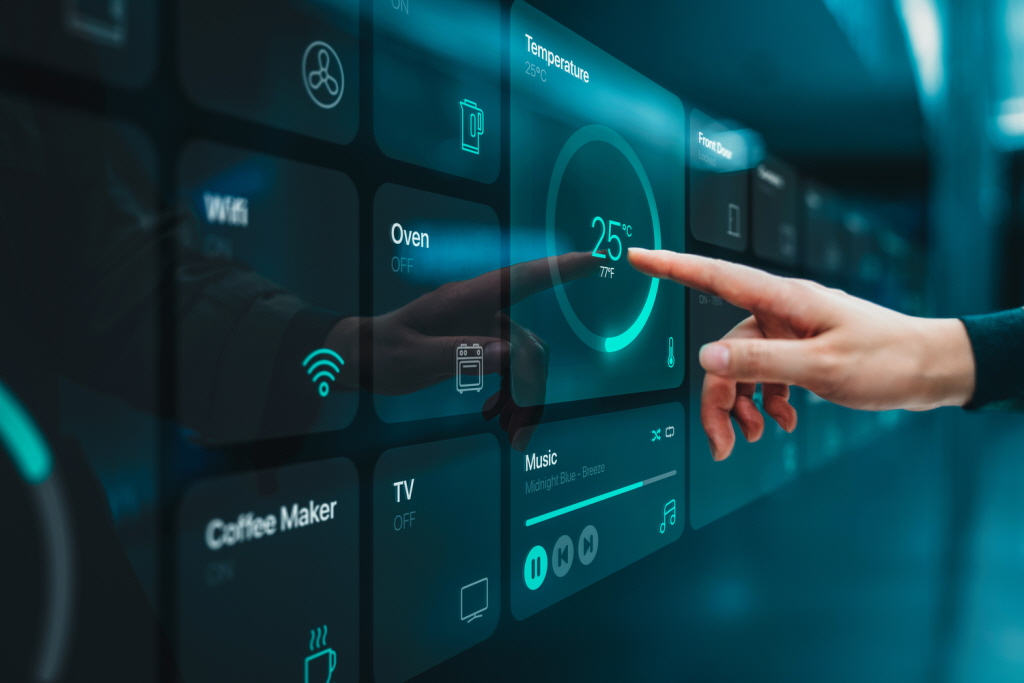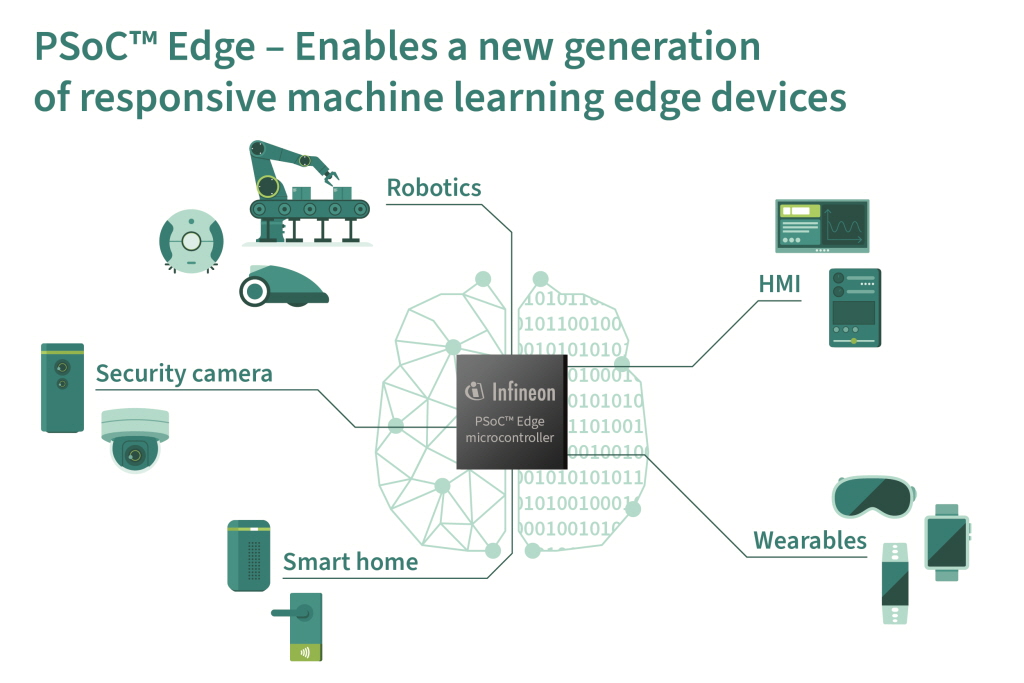[기술기고] Omar Cruz, 인피니언 테크놀로지스-에지 AI가 가져올 IoT의 미래
기사입력 2024.06.03 08:50

“AI 개발, 툴 체인 솔루션으로 해결”
에지 AI 디바이스 개발, 전문성 없이 불가능
인피니언 PSoC™ Edge, 쉽고·전문적 해결책
에지 AI 디바이스 개발, 전문성 없이 불가능
인피니언 PSoC™ Edge, 쉽고·전문적 해결책
오늘날 우리는 IoT의 폭발적인 증가를 목격하고 있다. 매초마다 127개의 디바이스가 인터넷으로 연결되고 있으며, 2027년에 이르면 IoT 디바이스 수가 430억 개에 달할 것으로 전망된다.
이 시장이 성장하고 발전함에 따라서, 삶의 질을 높이기 위한 좀 더 정교하고 강력하고 효율적이고 정확한 시스템 솔루션에 대한 요구 또한 높아지고 있다.
IoT의 이러한 흥미로운 미래를 가능하게 하는 많은 중요한 기술들 중에서 에지 AI는 에지에서 데이터 분석, 예측적 통찰, 지능형 의사결정을 가능하게 함으로써 IoT의 능력을 끌어올릴 것으로 기대된다.
먼저 기초적인 것에서부터 시작해 보자. 그렇다면 에지 AI란 무엇인가?
개발자들이나 사용자들은 인공 지능(AI)이나 머신 러닝(ML)에 대해서는 익숙할 텐데, 에지 AI라는 용어에 대해서는 그만큼 익숙하지는 않은 것 같다.
에지 인공 지능(에지 AI)은 클라우드 컴퓨팅 설비 같은 중앙 환경이 아니라 데이터가 발생되는 곳 가까이의 에지 컴퓨팅 환경이나 디바이스에 AI 애플리케이션을 구현하고 구축하는 것을 말한다.
좀 더 구체적으로, 에지 AI는 센서나 여타 소스들(트래커나 건강 모니터링 디바이스 같은)로부터 데이터를 수집하고, 이 데이터를 곧바로 에지 디바이스에서 AI 모델을 사용해서 처리하고, 이 모델의 출력을 사용해서 동작을 취하거나 알림을 전송한다.
에지 AI는 데이터를 로컬에서 처리함으로써 훨씬 더 빠르게 추론을 수행하고 실시간 활용 사례를 지원할 수 있으며, 지연시간과 네트워크 트래픽을 줄이고, 프라이버시와 보안을 향상시키고, 에너지 효율을 높일 수 있다.
오늘날 개발자들은 에지 AI를 적용한 다양한 활용 사례와 애플리케이션을 구상하고 있다. 가전기기와 스마트 홈 시스템, 웨어러블 디바이스, 건강 모니터링 디바이스에 사용되는 음성/제스처 인식, 공장 자동화에 사용되는 예측적 유지보수, 의심스러운 활동을 실시간으로 감지하고 처리할 수 있는 보안 카메라 같은 것을 들 수 있다. 이러한 활용 사례들을 사용해서 효율을 높이고 비용을 절감할 수 있다.
AI를 적용한 대표적인 활용 사례로서 일련의 복잡한 AI 기술을 바탕으로 음성 인식 분석을 활용한 스마트 스피커와 음성 비서를 들 수 있다.
이들 활용 사례는 자동 음성 인식(ASR)을 사용해서 소리 파장을 단어로 변환하고, 이러한 단어를 자연어 이해(Natural Language Understanding) 기술을 사용해서 실제 의미로 변환하고, 스마트 스피커가 자연어 생성(Natural Language Generation) 기술을 사용해서 응답한다.
스마트 홈 시장에 AI를 활용해서 에지 디바이스의 효율을 높이고 원활한 사용자 경험을 제공할 수 있다.
세탁기의 경우 물높이와 세제량뿐만 아니라 헹굼과 탈수 횟수를 조절해서 좀 더 효율적인 세탁을 할 수 있으며, 온도조절기는 사용자가 선호하는 온도를 감지하고 실내 및 실외 온도를 감지하고 실내에 있는 인원 수를 감지할 수 있으며, 오븐은 사용자의 기호에 따라서 음식을 준비하고 어른만 사용할 수 있도록 함으로써 안전을 높일 수 있으며, 진공청소기는 바닥 종류에 따라서 청소를 최적화하고 배터리 효율을 높일 수 있다.
이러한 모든 활용 사례들이 에지에서 복잡한 AI 알고리즘을 활용한 것이다.

▲그림 1 : PSoC™ Edge의 주요 애플리케이션
새로운 트렌드나 새로운 기술은 해결해야 할 새로운 과제 또한 제기한다. 에지 AI도 예외가 아니다. 에지 AI는 특히 다음과 같은 측면을 고려해야 한다.
- 높은 성능(과 낮은 전력) :
IoT의 증가는 더 많은 센서를 필요로 하고, 각종 센서로부터 더 많은 정보를 공유해야 하며, 이것은 디바이스의 복잡성을 높이고 더 강력한 컴퓨팅 성능을 필요로 하는 것으로 이어진다.
디바이스 자체에서 ML 동작을 처리할 수 있기 위해서는 새로운 세대의 에지 디바이스에 고성능 코어와 신경망 처리 가속화기를 필요로 한다.
여기에 전력 최적화 요구까지 더하면 일은 훨씬 까다로워진다. 배터리로 작동되는 디바이스는 효율적인 실행으로 배터리 전력을 절약하는 것이 중요하기 때문이다.
모든 것을 클라우드로 전송할 필요 없이 에지 디바이스에 데이터를 저장하고 알고리즘을 실행함으로써 소모되는 에너지를 줄일 수 있다.
- 보안과 프라이버시
에지 AI 디바이스는 대부분의 동작과 데이터 처리를 자체에서 수행하고 클라우드와 외부 장소로 전송하는 데이터가 적기 때문에 보안과 프라이버시 문제를 완화할 수 있다.
그렇다고 에지 AI 디바이스의 모든 데이터가 공격으로부터 안전하다는 뜻은 아니다. 보안 공격이 날로 진화하고 있으므로, 데이터 무결성과 프라이버시를 보호하기 위해서는 에지 AI 디바이스에 적정한 규모의 견고한 임베디드 보안이 필요하다.
- 전문성 부족과 소요되는 시간
해당 분야에 대한 전문성 없이는 에지 AI 디바이스를 개발하기가 거의 불가능하다.
이것은 AI/ML 용으로 특정한 가속화기나 프로세서를 어떻게 사용할지에 관한 하드웨어 지식의 부족일 수도 있고, AI 모델을 개발하고 구축하기 위해서 소프트웨어를 어떻게 사용할지에 관한 전문성 부족일 수도 있다.
지식의 부족이나 시간이 소요되는 문제 때문에 개발자들이 최상의 접근법을 취하지 못하거나 경영진이 적절한 의사결정을 하지 못할 수 있다.
바로 이럴 때 포괄적이고도 견고한 하드웨어 및 소프트웨어와 전문가들이 제공하는 일체의 툴체인 솔루션을 활용함으로써 차세대 에지 AI 디바이스를 개발할 때 불확실성을 줄이고 개발 시간을 단축할 수 있다.
인피니언의 PSoC™ Edge는 에지 AI의 과제를 해결하는 새로운 마이크로컨트롤러 제품군으로, 높은 성능, 저전력, 최신 보안, 그 밖의 다양한 기능을 특징으로 하여 개발자들이 개발 시간을 단축하도록 한다.
앞서 언급했듯이, 센서를 융합하고 에지에서 복잡한 데이터를 처리하기 위해서 시스템 복잡성이 높아지면서 갈수록 더 높은 성능의 마이크로컨트롤러가 요구되고 있다.
이와 함께 낮은 전력 소모와 높은 에너지 효율이 IoT에 중요하게 요구된다. 이러한 요구를 충족하기 위해서 인피니언은 PSoC™ Edge에 다중 도메인 아키텍처를 도입했다.
그럼으로써 고성능 코어와 하드웨어 가속화 신경망 프로세서 유닛 같은 고성능 기능을 제공하는 것과 함께, 항상 켜져 있어야 하는 ‘always-on’ 애플리케이션 용으로 초저전력 도메인을 제공함으로써 에너지 효율을 높이도록 한다.
IoT 디바이스가 딥 슬립 모드로 있다가 음향 이벤트나 얼굴 인식 동작을 감지하면 시스템을 깨우고 필요한 작업을 수행하고 다시 슬립 모드로 돌아간다.
그러므로 성능을 희생하지 않으면서 에너지 효율을 극대화하고 배터리 수명을 연장한다. 따라서 에지 AI는 디지털화를 가속화할 뿐만 아니라 전력 최적화를 통해서 탈탄소화에 기여한다.
또 다른 핵심 과제는 데이터를 안전하게 보호하고 보안 위협을 최소화하는 것이다.
따라서 솔루션 제공업체는 소비자에게 더 안전한 디바이스를 제공할 수 있도록 에지 AI 제품에 더 높은 수준의 보안 기능을 탑재할 필요가 있다.
에지 AI 디바이스를 적절히 보호하지 않으면 공격자들이 네트워크로 침입하기 위한 진입 지점이 될 수 있다.
또한 이 경우 공격자는 온도 조절기, 스마트 스피커, 스마트 잠금장치 등 시중에서 널리 사용되는 이러한 에지 AI 지원 디바이스를 확보하여 취약점을 분석하고 악성 소프트웨어를 만들어 기술과 네트워크를 손상시킬 수 있다.
이러한 이유로 새로운 에지 AI 디바이스에는 PSoC TM Edge가 도입한 것과 같은 견고하고 적절한 크기의 임베디드 보안 아키텍처가 가장 중요하다.
마지막으로 인피니언은 에지 AI 디바이스의 시장 출시 기간의 중요성을 잘 알고 있다.
최근 Imagimob을 인수한 인피니언은 이제 양산급 ML 모델을 제공하는 데 중점을 두고 높은 유연성과 사용 편의성을 갖춘 엔드투엔드 ML 플랫폼을 제공할 수 있는 역량을 추가했다.
유능한 에코시스템 파트너, 포괄적인 문서, 커넥티비티와 HMI 모듈이 포함된 평가 키트, 업계에서 인정받는 ModusToolbox™ 소프트웨어는 물론 Imagimob의 에지 AI 개발 플랫폼과 Ready Model에 이르기까지 일체의 하드웨어, 소프트웨어, 툴을 제공함으로써 PSoC™ Edge는 개발자들이 개발 시간을 단축하고 빠르게 제품을 출시하도록 한다.
여기로 클릭하면 인피니언이 어떻게 차세대 에지 AI 디바이스를 가능하게 하는지 볼 수 있다.
많이 본 뉴스
[열린보도원칙] 당 매체는 독자와 취재원 등 뉴스이용자의 권리 보장을 위해 반론이나 정정보도, 추후보도를 요청할 수 있는 창구를 열어두고 있음을 알려드립니다.
고충처리인 장은성 070-4699-5321 , news@e4ds.com
.jpg)


.jpg)
.JPG)



